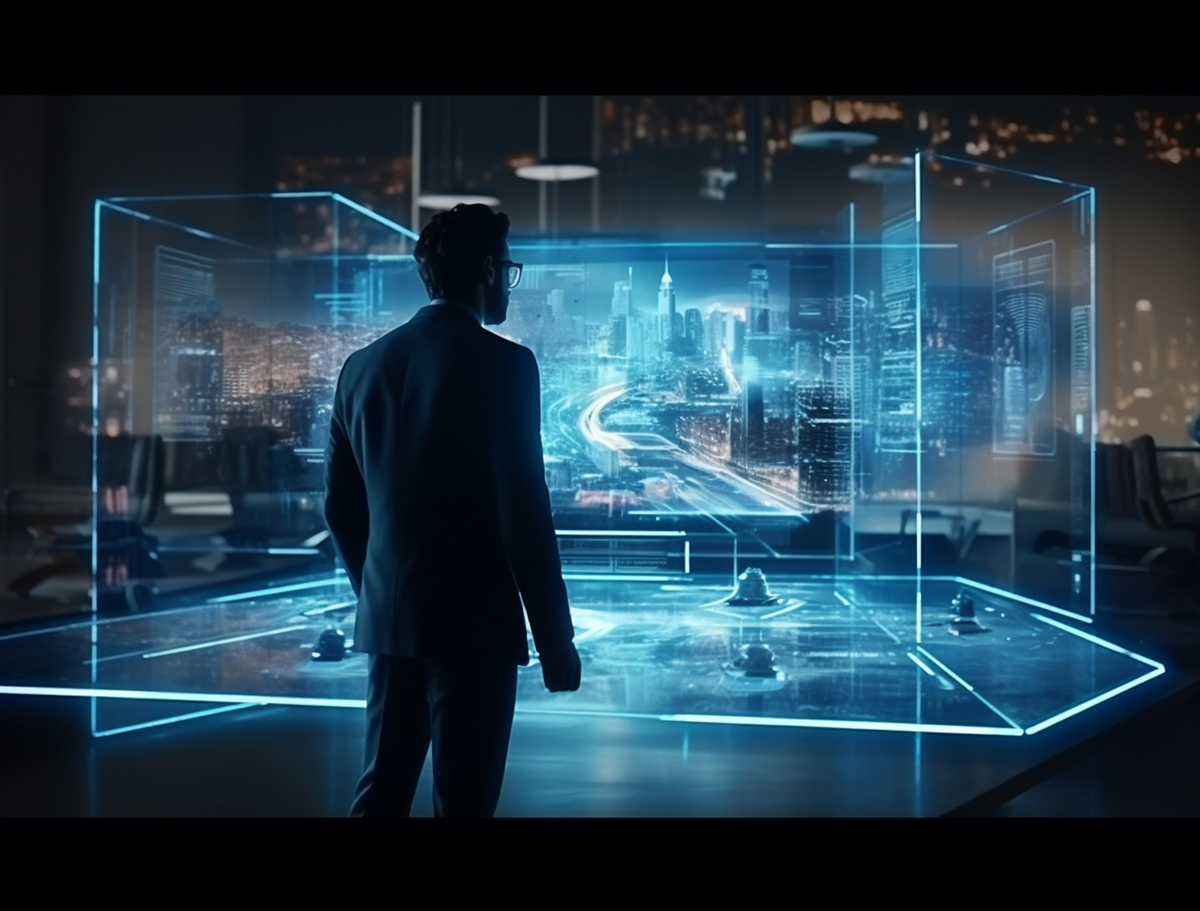Exclusive Neuroject Article: In the realm of architecture, the fusion of Artificial Intelligence (AI) has ignited a revolution, redefining the very essence of design, sustainability, and innovation. As of the present landscape, statistics reveal a profound impact of AI in architecture practices, promising a paradigm shift in the industry’s modus operandi.
Statistics unveil the rapid ascent of AI in architecture, with an estimated 68% of architectural firms actively exploring or implementing AI-driven tools and methodologies by 2024. This surge isn’t merely about technological integration; it signifies a transformative journey where creativity converges with computational capabilities, reshaping the dynamics of design processes and architectural outcomes.
Furthermore, studies showcase that AI-powered design tools have contributed to 25-30% efficiency gains in architectural workflows, streamlining tasks such as generative design, sustainability optimization, and predictive analytics. The predictive prowess of AI in architecture isn’t just a theoretical concept; it’s a tangible force reshaping architectural foresight, enabling architects to foresee environmental impacts, energy efficiencies, and structural considerations with unprecedented accuracy.
Beyond the realm of efficiency, Artificial Intelligence’s influence extends to sustainability, a cornerstone in modern architectural ethos. Reports indicate that AI-driven sustainability optimizations have led to up to 20% reduction in energy consumption and carbon emissions in buildings, underscoring AI’s role in crafting eco-conscious and resource-efficient architectural solutions.
In this landscape of innovation and statistics, the integration of AI in architecture emerges not as a fleeting trend but as a transformative force reshaping the very foundation of architectural practice. It’s a journey where statistics illuminate the impact, promising an era where design ingenuity harmonizes with technological prowess, catapulting architectural endeavors into a realm of unprecedented creativity, efficiency, and sustainability.
Table of Contents
The Current Landscape of AI in Architecture
The current landscape of AI in architecture reflects a paradigm shift, where innovative technologies are reshaping traditional practices and amplifying architectural capabilities. As of 2024, Artificial Intelligence’s integration into the architectural sphere has led to several notable trends and advancements.
Design Optimization
AI-driven tools have revolutionized design processes. Generative design, a prominent application, harnesses Artificial Intelligence algorithms to generate numerous design alternatives based on specified parameters to produce AI architecture. Architects can explore a myriad of design options efficiently, optimizing for various criteria like structural integrity, sustainability, and aesthetic appeal.
Data-Driven Decision Making
AI in architecture empowers architects with data-driven insights. By analyzing extensive datasets from past projects, Artificial Intelligence predicts design outcomes, evaluates material performance, and anticipates environmental impacts. This data-centric approach enhances informed decision-making throughout the design and planning phases.
Computational Design and Simulation
Computational design tools, powered by AI in architecture, facilitate complex simulations. Architects utilize these simulations to assess the behavior of structures under diverse conditions, optimizing designs for performance and functionality. AI-driven simulations aid in predicting a building’s behavior in response to environmental factors, aiding in sustainability initiatives.
Suggested article to read: Artificial Intelligence or AI in Construction Industry
Virtual and Augmented Reality
AI-infused Virtual Reality (VR) and Augmented Reality (AR) technologies are transforming architectural visualization and client engagement. Architects leverage immersive VR experiences to present designs, enabling clients to navigate virtual spaces and make informed decisions. AR overlays digital elements onto physical environments, enhancing visualization during construction phases.
Sustainable Design
AI in architecture plays a pivotal role in advancing sustainable design practices. By analyzing environmental data and energy consumption patterns, AI in architecture aids architects in optimizing designs for energy efficiency, material usage, and ecological impact. This facilitates the creation of environmentally conscious buildings aligned with sustainability goals.
Challenges and Ethical Considerations
The integration of AI in architecture is not without challenges. Ethical considerations, including data privacy, algorithmic bias, and the ethical use of AI-generated designs, remain crucial concerns. Architects grapple with ensuring Artificial Intelligence systems align with ethical standards and mitigate biases in design outcomes.
Adoption and Training
While AI in architecture offers transformative potential, its widespread adoption in the architectural community requires concerted efforts. Architects need access to training and education to effectively leverage Artificial Intelligence tools. Bridging the gap between Artificial Intelligence proficiency and architectural practice remains an ongoing endeavor.
Collaborative Platforms and Interdisciplinary Integration
AI in architecture facilitates collaborative platforms, encouraging interdisciplinary collaborations among architects, engineers, and data scientists. Such collaborations leverage Artificial Intelligence’s capabilities to address complex architectural challenges, encouraging cross-disciplinary innovation.
The current landscape of AI in architecture represents a dynamic fusion of technology and creativity. While AI in architecture augments architectural capabilities, architects continue to navigate challenges and ethical considerations in its integration, striving to harness Artificial Intelligence’s potential responsibly. As AI in architecture adoption continues to evolve, it promises to reshape architectural practice, unlocking new realms of creativity, efficiency, and sustainability.

Key Components of AI in Architecture
The integration of AI in architecture introduces transformative components that revolutionize traditional practices, enhancing efficiency, creativity, and decision-making processes. As of 2024, several key components highlight Artificial Intelligence’s impactful role within the architectural landscape, influencing various facets of design and construction.
Generative Design
Generative design stands as a cornerstone of AI in architecture integration in architecture. It harnesses the power of algorithms to explore an extensive array of design possibilities. Architects input specific parameters and constraints, allowing AI in architecture to generate numerous iterations of designs. This iterative process optimizes designs based on multifaceted criteria, including structural integrity, energy efficiency, spatial configurations, and aesthetic preferences. By leveraging AI-driven generative design tools, architects can efficiently explore innovative design alternatives that transcend conventional boundaries.
Suggested article to read: Best AI Architecture Generators
Data Analysis and Predictive Modeling
AI in architecture facilitates data-driven decision-making by analyzing extensive datasets, historical project data, and real-time information. Machine learning algorithms process and interpret vast amounts of architectural data, extracting valuable insights that inform design choices. Predictive modeling capabilities enable architects to forecast project outcomes, assess material performance, and anticipate environmental impacts. By extrapolating from past data, Artificial Intelligence assists architects in making informed decisions throughout the design and planning phases, enhancing the efficiency and accuracy of architectural projects.
Virtual Reality (VR) and Augmented Reality (AR)
AI-powered VR and AR technologies revolutionize architectural visualization and client engagement. VR immerses stakeholders in virtual environments, allowing them to navigate and experience architectural designs firsthand. This immersive experience facilitates better understanding and decision-making among clients and architects. On the other hand, AR overlays digital elements onto physical environments, enabling architects to visualize proposed designs within existing spaces. By leveraging AI-driven VR and AR, architects enhance communication, streamline design reviews, and create engaging presentations that facilitate collaborative decision-making processes.
Computational Design and Simulation
AI-driven computational design tools empower architects to conduct intricate simulations and analyses. These simulations simulate and predict the behavior of architectural structures under various conditions, facilitating performance optimization. AI in architecture assists in assessing structural integrity, thermal efficiency, and other critical parameters. Architects can predict a building’s response to environmental factors, enabling them to optimize designs for sustainability and functionality. The integration of Artificial Intelligence in computational design and simulation empowers architects to experiment, iterate, and refine designs to achieve desired performance goals.
Sustainable Design
AI in architecture plays a pivotal role in advancing sustainable design practices within architecture. By analyzing extensive environmental data and energy consumption patterns, AI in architecture informs architects about sustainable design strategies. Machine learning algorithms optimize designs to minimize environmental impact, enhance energy efficiency, and promote sustainable material usage. AI-driven tools aid architects in creating buildings that prioritize eco-friendly features, aligning with sustainability goals and certifications.
Suggested article to read: Best Construction AI Software
Challenges and Ethical Considerations
The integration of AI in architecture presents challenges and ethical considerations. Architects grapple with ethical dilemmas concerning data privacy, algorithmic bias, and the responsible use of AI-generated designs. Ensuring that Artificial Intelligence systems adhere to ethical standards and mitigate biases in design outcomes remains a significant concern. Additionally, architects need to address challenges related to adapting to new technologies, navigating regulatory frameworks, and fostering a responsible AI in architecture culture within architectural practice.
Adoption and Training
Effective utilization of Artificial Intelligence tools in architecture necessitates training and education for architects to leverage these technologies optimally. Bridging the gap between Artificial Intelligence proficiency and architectural practice remains a crucial endeavor. Architects require access to training programs that equip them with the necessary skills to integrate AI in architecture into their workflow effectively.
Collaborative Platforms and Interdisciplinary Integration
AI in architecture fosters collaborative platforms that encourage interdisciplinary collaboration among architects, engineers, and data scientists. These collaborations leverage Artificial Intelligence’s capabilities to address complex architectural challenges. By facilitating cross-disciplinary innovation, AI in architecture integration encourages diverse perspectives and expertise, fostering holistic solutions to architectural problems.
In summary, the integration of Artificial Intelligence components in architecture signifies a transformative shift, augmenting the creative and technical capabilities of architects. As AI in architecture continues to evolve and permeate architectural practices, architects navigate challenges while embracing its potential to revolutionize design, construction, and sustainability within the built environment.

AI-Integrated Design Tools
AI-integrated design tools represent a significant advancement in the architectural realm, revolutionizing conventional design processes and empowering architects with cutting-edge capabilities. These tools leverage Artificial Intelligence algorithms and machine learning to streamline various aspects of architectural design. As of 2024, these tools encompass several essential functionalities that redefine the way architects conceptualize, iterate, and execute their designs.
Suggested article to read: Best AI Tools for Project Management
Generative Design Platforms
Generative design platforms powered by Artificial Intelligence algorithms enable architects to explore a multitude of design options efficiently. Architects input project parameters and constraints, allowing the AI in architecture system to generate and iterate through numerous design iterations. By analyzing vast datasets and considering various criteria such as structural integrity, environmental impact, and user preferences, these platforms produce optimized design alternatives that transcend traditional boundaries.
Data-Driven Decision Support
AI-infused tools analyze extensive datasets from past projects and real-time information, providing valuable insights to inform design decisions. By leveraging machine learning capabilities, these tools assist architects in predicting project outcomes, evaluating material performance, and anticipating environmental impacts. This data-driven approach enhances architects’ decision-making processes, optimizing designs for efficiency, sustainability, and functionality.
Virtual Reality (VR) and Augmented Reality (AR) Visualization
AI-driven VR and AR technologies revolutionize architectural visualization and client engagement. These tools immerse stakeholders into virtual environments, enabling them to experience architectural designs realistically and interactively. Architects leverage VR to navigate and visualize spaces, while AR overlays digital elements onto physical environments, allowing for visualizing proposed designs within existing contexts. These immersive experiences enhance communication, facilitate design reviews, and foster collaborative decision-making processes.
Computational Analysis and Simulation
AI-integrated tools facilitate complex simulations and analyses that predict the behavior of architectural structures under diverse conditions. These simulations assess factors such as structural integrity, thermal performance, and sustainability metrics. By leveraging Artificial Intelligence algorithms, architects can predict a building’s response to environmental variables, enabling iterative improvements to designs for optimal performance.
Sustainable Design Optimization
AI-driven design tools optimize designs for sustainability by analyzing environmental data and energy consumption patterns. Machine learning algorithms aid architects in creating environmentally friendly buildings by suggesting design changes that reduce ecological footprints, promote energy efficiency, and optimize material usage. These tools enable architects to meet sustainability goals and certifications seamlessly.
Challenges and Future Development
Despite their potential, AI-integrated design tools face challenges related to data privacy, algorithmic bias, and ensuring responsible Artificial Intelligence usage. Architectural firms are continually working on addressing these challenges and refining Artificial Intelligence tools to improve accuracy, efficiency, and ethical considerations. The future development of these tools involves advancing capabilities to better cater to the specific needs of architects, further enhancing design creativity, efficiency, and sustainability within the architectural domain.
Examples of Artificial Intelligence Apps for Architecture
Artificial Intelligence applications have infiltrated architectural practice, offering a spectrum of tools and platforms that revolutionize design processes, enhance sustainability initiatives, and streamline architectural workflows. As of 2024, numerous AI-powered applications have emerged, reshaping how architects conceptualize, design, and execute projects. Here are some notable examples:
1. Generative Design Platforms
AI-driven generative design platforms, such as Autodesk’s Generative Design, leverage algorithms to generate countless design iterations based on user-defined parameters. Architects input design constraints, and Artificial Intelligence generates optimized solutions. These platforms aid in conceptualizing complex structures, optimizing space utilization, and exploring innovative design possibilities.
2. Sustainability Optimization Tools
AI in architecture applications like Sefaira and Cognitive Building Advisor focus on sustainability by analyzing building performance metrics. They employ Artificial Intelligence algorithms to assess energy efficiency, daylighting, and thermal comfort within proposed designs. Architects can simulate and optimize building performance in real-time, ensuring environmentally conscious design choices.
3. Computational Design and Analysis
AI-driven computational design tools, such as Rhino Inside, integrate Artificial Intelligence algorithms into CAD software, allowing architects to explore parametric design and complex geometries. Additionally, Ladybug Tools utilizes AI in architecture for environmental analysis, aiding in simulating sunlight exposure, airflow, and building energy consumption, influencing design decisions for optimal performance.
4. Augmented Reality (AR) and Virtual Reality (VR) Solutions
AI-powered AR and VR applications like Morpholio AR and Enscape enable immersive experiences for architects and clients. These tools use AI in architecture to visualize designs in real-world settings, facilitating better communication, design validation, and enhanced client engagement by showcasing lifelike 3D models within physical spaces.
5. Project Management and Collaboration Platforms
AI-based project management tools such as BIM 360 and Procore incorporate machine learning algorithms to streamline project workflows. These platforms analyze project data, predict potential risks, optimize schedules, and enhance collaboration among project stakeholders, ensuring smoother project execution.
6. Image Recognition and Design Assistance
AI-powered image recognition tools like Superspace and SketchUp utilize machine learning to identify objects or architectural elements in images. They assist architects in cataloging reference images, creating mood boards, and generating design inspirations based on recognized elements, facilitating the design conceptualization process.
7. Intelligent Material Selection
Applications like Material.AI leverage AI in architecture to assist architects in selecting materials. These tools analyze material properties, cost data, and environmental impact, recommending suitable materials for specific design requirements, and promoting sustainable and efficient material usage.
8. Acoustic Design and Simulation
AI-based acoustic design software such as Odeon and SoundFlow uses machine learning to simulate sound propagation within architectural spaces. Architects can predict and optimize acoustics in buildings, ensuring optimal sound quality and mitigating noise issues during the design phase.
9. AI-Integrated Building Information Modeling (BIM)
AI-integrated BIM solutions, like ARCHICAD and Revit, incorporate machine learning algorithms to automate repetitive tasks, improve clash detection, and optimize design workflows. These platforms assist in generating accurate models, facilitating efficient documentation, and aiding collaboration among multidisciplinary teams.
The integration of AI in architecture applications within architectural practice offers an array of tools that empower architects to innovate, optimize, and realize design visions more efficiently and sustainably than ever before. As AI in architecture continues to evolve, these applications promise to further revolutionize the architectural landscape, pushing the boundaries of design creativity and technological advancement.

The Impact on Architectural Creativity
The integration of AI in architecture has sparked a paradigm shift, impacting the creative processes and methodologies architects employ in envisioning, conceptualizing, and executing designs. As of 2024, Artificial Intelligence’s influence on architectural creativity transcends mere assistance; it fundamentally transforms the creative landscape, fostering innovation, exploration, and efficiency while reshaping traditional workflows.
Augmenting Creativity with AI-Driven Tools
Artificial Intelligence’s role in architecture extends beyond computational efficiencies; it catalyzes augmenting human creativity. AI-driven tools, such as generative design platforms, assist architects in exploring an expansive array of design options. By leveraging vast datasets, algorithms generate and iterate through design alternatives that push the boundaries of conventional thinking. This collaborative partnership between architects and AI in architecture augments creative ideation by providing novel insights and unconventional design solutions.
Enhancing Iterative Design Processes
Artificial Intelligence’s ability to process massive datasets expedites iterative design processes. Architects can rapidly explore and evaluate multiple design iterations, fostering an environment conducive to experimentation and innovation. These tools facilitate the exploration of diverse architectural concepts, encouraging architects to push creative boundaries and challenge preconceived notions, resulting in designs that prioritize both aesthetics and functionality.
Leveraging Data-Driven Insights for Innovation
The fusion of Artificial Intelligence with architectural creativity relies on data-driven insights. Artificial Intelligence algorithms analyze historical project data, environmental parameters, and user preferences, providing architects with invaluable insights into design performance and user behavior. By leveraging these insights, architects can innovate and tailor designs to meet specific user needs while addressing environmental concerns, fostering designs that are not just aesthetically pleasing but also responsive to contextual and functional requirements.
Redefining Problem-Solving Approaches
Artificial Intelligence’s integration introduces architects to new problem-solving paradigms. With access to AI-driven computational analyses and simulations, architects can predict and evaluate design outcomes under diverse conditions. This predictive capability fosters a proactive approach to design challenges, enabling architects to address potential issues before they arise. Architects can explore unconventional solutions and experiment with design elements confidently, knowing they have AI-enabled tools that offer predictive insights into design performance.
Balancing Human Ingenuity with Artificial Intelligence Assistance
While AI in architecture augments creativity, its role remains complementary to human ingenuity. Architects navigate the delicate balance between AI-generated insights and their creative intuition. Artificial Intelligence serves as a tool to amplify, not replace, human creativity. Architects harness AI’s computational prowess to expand the realm of possibilities, facilitating a symbiotic relationship where human expertise guides AI-driven insights toward innovative design solutions.
Fostering Collaborative Design Processes
AI in architecture promotes collaborative design environments by enabling multidisciplinary interactions. Architects collaborate with engineers, data scientists, and other professionals, leveraging AI-driven tools to co-create innovative solutions. These collaborations foster cross-disciplinary exchanges that enrich creative perspectives, leading to holistic designs that integrate diverse expertise and address complex architectural challenges.
Ethical Considerations and Human-Centric Design
The integration of AI in architecture raises ethical considerations concerning responsible design and user-centric approaches. Architects navigate ethical dilemmas surrounding data privacy, bias in AI-generated designs, and the ethical implications of AI-driven decision-making. Balancing technological advancements with ethical considerations ensures that AI-enhanced designs prioritize user well-being, inclusivity, and ethical practices.
Future Outlook
The future of AI in architecture creativity holds immense promise. Architects will continue to explore and refine Artificial Intelligence’s role in stimulating creative processes. AI’s evolution will likely offer more sophisticated tools that seamlessly integrate with architectural workflows, enhancing creativity, efficiency, and sustainability. Architects, equipped with AI-driven insights, will push the boundaries of innovation, fostering a future where creativity flourishes in harmony with technological advancements.
In conclusion, the integration of AI in architecture augments creativity by offering new perspectives, accelerating iterative processes, and fostering collaborative environments. Architects embrace Artificial Intelligence as a creative partner, leveraging its computational capabilities to navigate complex design challenges and redefine the boundaries of architectural innovation. As AI in architecture continues to evolve, architects stand at the precipice of a transformative era, where creativity, propelled by AI-driven insights, leads to unprecedented architectural achievements.
Challenges and Ethical Considerations
The integration of AI in architecture brings forth a multitude of opportunities, but it also poses significant challenges and ethical considerations that architects must navigate carefully. As of 2024, the adoption of AI in architecture practice has encountered several challenges and ethical dilemmas that warrant attention and resolution.
Data Privacy and Security
Architects grapple with concerns regarding the privacy and security of data utilized by Artificial Intelligence systems. The vast amount of sensitive architectural data, including designs, client information, and project details, raises apprehensions about unauthorized access, data breaches, and potential misuse. Ensuring robust data security measures and implementing encryption protocols becomes imperative to safeguard sensitive architectural information.
Algorithmic Bias and Fairness
AI in architecture algorithms, reliant on historical data, may exhibit biases that inadvertently perpetuate societal inequalities or favor specific design styles. Biases in datasets can lead to skewed design recommendations or reinforce existing architectural stereotypes. Architects must actively mitigate biases by critically evaluating AI-generated insights, diversifying datasets, and ensuring fairness and inclusivity in design outcomes.
Responsible Use of AI-Generated Designs
The ethical use of AI-generated designs poses ethical quandaries. Architects confront dilemmas concerning the authorship, ownership, and authenticity of AI-generated designs. The distinction between human creativity and AI-generated outputs blurs ethical boundaries, raising questions about attribution, intellectual property rights, and the acknowledgment of Artificial Intelligence’s role in the creative process.
Transparency and Accountability
The opacity of AI in architecture algorithms presents challenges in understanding and explaining the decision-making processes. Architects may face difficulties in comprehending the intricate workings of Artificial Intelligence systems, hindering transparency and accountability. Ensuring transparency in Artificial Intelligence operations and establishing accountability frameworks becomes crucial to fostering trust and reliability in AI-generated design insights.
Adaptation and Skill Development
The integration of AI in architecture necessitates architects’ adaptation to new technologies and skill sets. Architects must undergo continuous learning and skill development to effectively leverage Artificial Intelligence tools and comprehend their implications on design processes. Bridging the gap between Artificial Intelligence proficiency and architectural practice requires comprehensive training programs and educational initiatives.
Ethical Artificial Intelligence Decision-Making
Architects encounter ethical dilemmas when relying on AI in architecture systems for critical decision-making. AI-driven design suggestions may conflict with ethical considerations, impacting user well-being, environmental sustainability, or cultural sensitivity. Architects grapple with ensuring that Artificial Intelligence recommendations align with ethical standards, reflecting human values and social responsibilities.
Regulatory and Legal Challenges
The rapid evolution of AI in architecture outpaces regulatory frameworks and legal standards within the architectural domain. Architects face uncertainties regarding compliance with evolving regulations, intellectual property rights, and liability issues associated with AI-generated designs. Navigating the legal landscape requires proactive engagement with policymakers to establish clear guidelines for AI integration in architecture.
Cultural and Social Implications
Artificial Intelligence’s influence on architectural creativity raises cultural and social implications. Architects must consider the socio-cultural context and community needs when utilizing Artificial Intelligence in design processes. Ethical considerations involve respecting cultural diversity, preserving heritage, and addressing societal impacts to ensure that AI-driven designs prioritize inclusivity and societal well-being.
Mitigating Ethical Risks
Addressing the challenges and ethical considerations necessitates a concerted effort from architects, industry stakeholders, policymakers, and AI in architecture developers. Collaborative initiatives aimed at developing ethical guidelines, implementing best practices, and fostering interdisciplinary dialogues are essential to mitigate ethical risks associated with Artificial Intelligence integration in architecture.
In conclusion, while Artificial Intelligence offers transformative potential in architectural practice, architects must navigate various challenges and ethical considerations. Striking a balance between technological advancements and ethical responsibilities remains crucial to ensure that AI in architecture integration in architecture promotes innovation, inclusivity, and societal well-being. Architects play a pivotal role in steering the ethical adoption of Artificial Intelligence, fostering responsible and human-centric architectural practices amidst the evolving technological landscape.

Future Trends and Innovations
As of 2024, the integration of AI in architecture sets the stage for a future brimming with transformative trends and innovations that promise to reshape architectural practice. Architects, empowered by AI-driven technologies, anticipate a trajectory of advancements that will revolutionize design processes, sustainability efforts, and user-centric approaches within the built environment.
AI-Driven Design Evolution
The future heralds an evolution in AI-driven design methodologies, where generative design platforms become more sophisticated. Artificial Intelligence algorithms will increasingly collaborate with architects in a co-creative process, generating design alternatives that harmonize human creativity with computational capabilities. Architects envision AI in architecture systems that not only optimize designs based on predefined criteria but also adapt and evolve iteratively, learning from user feedback and environmental factors to refine design solutions dynamically.
Biophilic Design Integration
Artificial Intelligence’s role extends to facilitating biophilic design integration within architectural practices. AI-powered tools will aid architects in leveraging natural elements and organic patterns to create environments that prioritize human well-being and connectivity with nature. Predictive analytics and machine learning algorithms will assist in designing spaces that foster well-being, reduce stress, and enhance productivity by integrating natural elements and daylighting strategies effectively.
AI-Enhanced Sustainability
The convergence of AI in architecture and sustainability in architecture remains a pivotal trend for the future. AI-driven tools will play a crucial role in optimizing designs for energy efficiency, material usage, and environmental impact. Architects envision Artificial Intelligence systems that predict the life cycle impact of designs, enabling the creation of buildings that are not only energy-efficient but also self-regulating, adaptive, and resilient to environmental changes.
Autonomous Construction
The future of construction involves an increased reliance on autonomous systems and robotics empowered by AI in architecture. Autonomous construction vehicles and robots equipped with AI in architecture algorithms will revolutionize construction sites, performing tasks such as 3D printing, bricklaying, and site inspections with precision and efficiency. Architects foresee AI-powered drones orchestrating site logistics, monitoring progress, and aiding in real-time decision-making throughout the construction phase.
Suggested article to read: Construction Robots
Human-Centric Artificial Intelligence Interfaces
Architects anticipate the emergence of AI-driven interfaces tailored to human-centric interactions. Natural Language Processing (NLP) and gesture-based interfaces will enable architects to engage with Artificial Intelligence systems intuitively, facilitating seamless communication and collaboration. These interfaces will transform the design process, allowing architects to articulate design intentions effortlessly and receive AI-generated insights in a user-friendly manner.
Computational Material Science
Artificial Intelligence’s influence extends to computational material science, revolutionizing material innovation and selection. Machine learning algorithms will analyze material properties and performance, suggesting novel materials or composites that enhance sustainability, durability, and functionality in architectural applications. Architects envision Artificial Intelligence systems that predict material behavior under various conditions, facilitating informed material selection and innovation.
AI-Driven Urban Planning
The future of urban planning involves AI-enabled solutions for designing sustainable and resilient cities. AI in architecture algorithms will analyze vast urban datasets, offering insights into optimizing urban layouts, transportation networks, and resource allocation. Architects and urban planners will leverage Artificial Intelligence models to create cities that prioritize sustainability, livability, and resilience in the face of evolving environmental and social challenges.
Ethical Artificial Intelligence Integration
As AI becomes more pervasive in architecture, architects foresee a greater emphasis on ethical Artificial Intelligence integration. Efforts to ensure responsible AI usage, mitigate biases, and promote inclusivity will shape the future of AI in architecture. Architects, in collaboration with policymakers and AI developers, will establish ethical guidelines and regulatory frameworks that prioritize ethical Artificial Intelligence practices in architectural design.
Collaborative AI Ecosystems
The future envisions a collaborative Artificial Intelligence ecosystem where architects, engineers, urban planners, and AI developers collaborate seamlessly. Interdisciplinary collaborations will foster innovation, leveraging AI’s capabilities to address complex challenges in architecture and urban design. Architects anticipate AI platforms that facilitate cross-disciplinary exchanges, driving holistic solutions that cater to societal, environmental, and technological advancements.
In conclusion, the future of AI in architecture promises a paradigm shift, where AI-driven innovations propel architectural practice into a new era of creativity, sustainability, and human-centric design. Architects embrace the transformative potential of Artificial Intelligence, leveraging its capabilities to redefine architectural solutions that cater to evolving societal needs, environmental challenges, and technological advancements. As AI continues to evolve, architects stand poised at the forefront of a dynamic landscape, embracing Artificial Intelligence as a catalyst for unparalleled innovation within the architectural domain.

Practical Implementation Strategies
Implementing AI in architecture demands a strategic approach that aligns technological integration with the unique requirements and challenges of architectural practice. As of 2024, architects embark on practical implementation strategies to effectively harness the potential of Artificial Intelligence, leveraging its capabilities to enhance design processes, sustainability initiatives, and user experiences within the built environment.
1. Define Clear Objectives
Architects must articulate clear objectives for Artificial Intelligence implementation aligned with the firm’s vision and goals. Whether enhancing design efficiency, improving sustainability, or fostering innovation, defining specific and measurable objectives provides a roadmap for effective Artificial Intelligence integration.
2. Assess Readiness and Capabilities
Conducting a comprehensive assessment of the firm’s readiness and technological capabilities is crucial. This involves evaluating existing infrastructure, and technological proficiency within the team, and identifying areas that necessitate upskilling or resource augmentation to accommodate Artificial Intelligence integration.
3. Identify Suitable Artificial Intelligence Applications
Architects should identify AI in architecture applications that align with their specific needs and objectives. AI-driven tools for generative design, computational analysis, sustainability optimization, or collaborative platforms offer diverse possibilities. Selecting appropriate AI applications that cater to the firm’s requirements is pivotal.
4. Pilot Projects and Prototyping
Initiate Artificial Intelligence integration through pilot projects or prototyping exercises. These initiatives allow architects to test AI in architecture applications in real-world scenarios, assess their effectiveness, and gauge their impact on design processes. Piloting AI in controlled settings aids in understanding its potential benefits and challenges.
5. Collaborate with Artificial Intelligence Experts
Collaborating with Artificial Intelligence experts or consultants facilitates a smoother integration process. Partnering with AI specialists provides valuable insights, technical expertise, and guidance in selecting, customizing, or developing Artificial Intelligence solutions tailored to the firm’s needs.
6. Data Preparation and Integration
AI in architecture relies on data; hence, preparing and integrating relevant datasets is crucial. Architects should ensure data quality, accessibility, and compatibility with AI algorithms. This involves organizing architectural data, incorporating historical project data, and establishing data governance protocols.
7. Training and Skill Development
Invest in training programs to equip architectural teams with Artificial Intelligence proficiency. Providing comprehensive training on Artificial Intelligence tools, algorithms, and their applications fosters a culture of continuous learning, enabling architects to leverage Artificial Intelligence effectively in their workflows.
8. Incremental Implementation
Adopt a phased approach to Artificial Intelligence implementation, starting with smaller-scale initiatives before scaling up. Gradual integration allows architects to address challenges, refine processes, and gain confidence in Artificial Intelligence tools before broader deployment.
9. Cultivate a Culture of Innovation
Foster an organizational culture that embraces innovation and experimentation. Encourage open communication, collaboration, and knowledge-sharing among team members to explore new ideas and possibilities offered by AI-driven technologies.
10. Monitor, Evaluate, and Iterate
Continuous monitoring and evaluation of Artificial Intelligence implementations are imperative. Architects should assess the impact of Artificial Intelligence on design outcomes, efficiency gains, user experiences, and sustainability metrics. Feedback loops enable iterative improvements and adaptations based on real-time insights.
11. Address Ethical and Regulatory Aspects
Consider ethical implications and compliance with regulatory frameworks during Artificial Intelligence implementation. Architects must ensure responsible AI in architecture usage, address biases, maintain data privacy, and adhere to ethical guidelines in architectural design practices involving AI in architecture.
12. Measure Return on Investment (ROI)
Assess the ROI of Artificial Intelligence implementations by quantifying the benefits derived from AI in architecture integration. Evaluate cost savings, efficiency improvements, design quality enhancements, and client satisfaction to ascertain the tangible value brought about by Artificial Intelligence.
13. Encourage User Feedback and Adaptation
Engage stakeholders, including clients, users, and design teams, to gather feedback on AI-integrated processes. Incorporate user feedback to refine AI in architecture applications, adapt workflows, and ensure alignment with user needs and preferences.
14. Scalability and Future-proofing
Consider the scalability of Artificial Intelligence implementations to accommodate future growth and technological advancements. Architectural firms should invest in flexible Artificial Intelligence solutions that can evolve and adapt to changing industry trends and emerging technologies.
15. Knowledge Sharing and Documentation
Document Artificial Intelligence integration processes, lessons learned, and best practices. Facilitate knowledge-sharing within the firm to create a repository of insights, fostering continuous improvement and facilitating smoother AI adoption in subsequent projects.
In conclusion, practical implementation strategies for AI in architecture entail a holistic approach that encompasses strategic planning, technological readiness, collaborative efforts, continuous learning, and ethical considerations. Architects embracing Artificial Intelligence integration embark on a transformative journey, leveraging technology to drive innovation, efficiency, and sustainability in architectural design practices. Effective implementation of AI in architecture not only revolutionizes design processes but also positions architectural firms at the forefront of technological advancement within the built environment.
Conclusion
The integration of AI in architecture signifies a transformative leap into an era where technology collaborates with creativity to redefine the boundaries of design, sustainability, and user-centric architecture. As architects navigate the implementation of AI, they embark on a journey poised at the intersection of innovation and ethical responsibility, shaping the future of the built environment.
AI in architecture isn’t merely about computational efficiency; it’s a synergy between human ingenuity and technological prowess. Architects harness AI in architecture as a tool, augmenting their creative potential and streamlining design processes while preserving the essence of human-centric design. The evolution of AI-driven tools facilitates iterative design exploration, sustainability optimization, and predictive analytics, empowering architects to craft environments that transcend traditional paradigms.
Yet, this journey isn’t without challenges. Ethical considerations, data privacy concerns, and the need for continuous upskilling underscore the complexities of AI in architecture integration. Architects must navigate these challenges, fostering ethical AI practices, advocating for responsible usage, and addressing biases to ensure that AI-driven solutions align with societal values and user needs.
As the architectural landscape evolves, AI in architecture promises boundless opportunities. It propels architects toward a future where design innovation is intertwined with sustainability, where predictive analytics drive smarter decisions, and where collaborative ecosystems foster holistic solutions. AI’s trajectory within architecture isn’t about replacing human creativity but enhancing it, cultivating an environment where technology and innovation serve as catalysts for transformative and empathetic design solutions.
In conclusion, the integration of AI in architecture marks a pivotal moment—a convergence of human creativity and technological advancement, steering architectural practice toward a horizon brimming with possibilities. Architects, as stewards of this transformation, navigate this dynamic landscape, leveraging Artificial Intelligence’s potential to sculpt a future where buildings resonate with purpose, sustainability, and human experiences, redefining the essence of architectural excellence in an AI-driven era.
Resources:
Itransition | The Guardian | Autodesk | Arch Daily | ARCHIVIBE | Dezeen | Maket.ai | Architectures | Architizer | StarryAI | The New York Times
For all the pictures: Freepik



